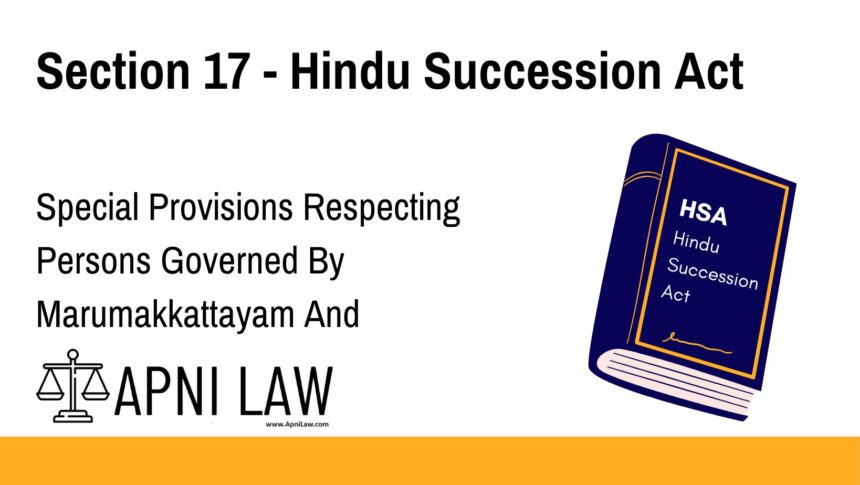Code: Section 17 of the Hindu Succession Act
Section 17 – Special Provisions for Persons Governed by Marumakkattayam and Aliyasantana Laws: The provisions of Sections 8, 10, 15, and 23 shall have effect in relation to persons governed by the Marumakkattayam law or Aliyasantana law as if:
- For sub-clauses (c) and (d) of Section 8, the following is substituted:
“(c) Thirdly, if there are no heirs in the first two classes, then property will pass to the deceased’s relatives, whether agnates or cognates.”
- For clauses (a) to (e) of sub-section (1) of Section 15, the following is substituted:
- (a) First, to sons, daughters (including the children of pre-deceased children), and the mother.
- (b) Second, to the father and husband.
- (c) Third, to the heirs of the mother.
- (d) Fourth, to the heirs of the father.
- (e) Finally, to the heirs of the husband.
- Clause (a) of sub-section (2) of Section 15 has been omitted.
- Section 23 has been omitted.
Explanation of Section 17
Section 17 introduces modifications to Hindu Succession Act rules for individuals traditionally governed by the Marumakkattayam and Aliyasantana systems. These changes allow for a smooth transition from the older customary laws to the new legal framework.
The primary objective of Section 17 is to provide clarity on how property should be inherited by individuals who were governed by these regional laws.
Key Changes Under Section 17:
- Changes in the Order of Heirs (Section 8)
Now, if there are no heirs in the primary categories, the property is transferred to the deceased’s relatives, whether through the male or female line. - Revised Order of Succession (Section 15)
The new rules specify a clear order of inheritance:- First, property is inherited by sons, daughters (including children of pre-deceased children), and the mother.
- Then, the father and husband inherit.
- The heirs of the mother and father come next.
- Finally, the husband’s heirs inherit.
- Omission of Clauses
The omission of Clause (a) in Section 15(2) and Section 23 has been done to better align the law with the practices of these traditional systems.
Illustration
Example 1: Marumakkattayam Law
A person governed by the Marumakkattayam law dies. The property will first be passed to the children and the mother. If no heirs exist in this group, it moves to the father, husband, and other relatives, as per the new order.
Example 2: Aliyasantana Law
Similarly, for someone under the Aliyasantana law, the inheritance follows the same revised order as described in Section 17. Sons, daughters, and the mother are the first in line, followed by the father and husband.
Common Questions and Answers on Section 17
1. What does Section 17 change for those governed by Marumakkattayam and Aliyasantana laws?
- Answer: Section 17 updates the order of succession for these individuals, making it consistent with the rest of the Hindu Succession Act. The order now prioritizes sons, daughters, and the mother before moving to the father, husband, and extended relatives.
2. How is property distributed under Section 17?
- Answer: Property first passes to the immediate family members, such as sons, daughters, and the mother. If no heirs are available, it passes to the extended family, including the father, husband, and their heirs.
3. Why were certain provisions omitted in Section 17?
- Answer: Sections 15(2)(a) and 23 were omitted because they were not in line with the customs of Marumakkattayam and Aliyasantana laws, which the section aims to accommodate.
Conclusion
Section 17 is designed to harmonize the inheritance laws for individuals governed by the Marumakkattayam and Aliyasantana systems. These changes provide a clearer and more structured approach to succession, ensuring consistency with the Hindu Succession Act.








